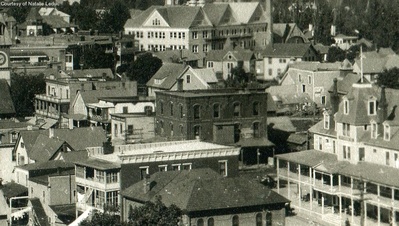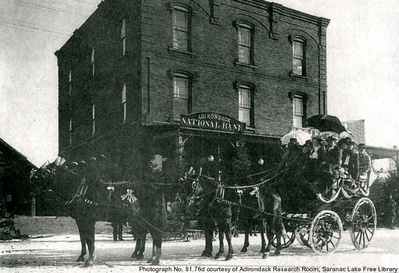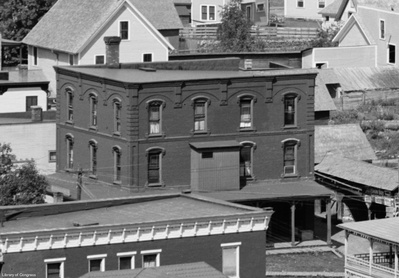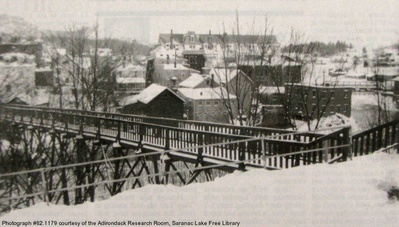 Spaulding Block, center. Riverside Inn at right; the old Main Street Saranac Lake High School, center back; clock tower of the old Harrietstown Town Hall at left
Spaulding Block, center. Riverside Inn at right; the old Main Street Saranac Lake High School, center back; clock tower of the old Harrietstown Town Hall at left  A stagecoach stopped on Main Street in front of the Spaulding Block, between 1897 and 1907. Adirondack Daily Enterprise, February 28, 2012
A stagecoach stopped on Main Street in front of the Spaulding Block, between 1897 and 1907. Adirondack Daily Enterprise, February 28, 2012  Spaulding Block, center. Riverside Inn at lower right (1885)
Spaulding Block, center. Riverside Inn at lower right (1885)  Spaulding Block, center. (Detroit Publishing Co., 1909) Address: torn down, 1955
Spaulding Block, center. (Detroit Publishing Co., 1909) Address: torn down, 1955
Old Address: 25-29 Main Street
Other names: Al Shortt/Ken Lawless Texaco, Wilson Farms, Verizon store
Year built: mid 1880s
From the Adirondack Daily Enterprise, December 12, 1992
The Spaulding Block, a focal point of village life
That old overworked cliche "gone but not forgotten" might well be genuinely applied to one of Saranac Lake's early commercial establishments that served a host of tenants during its 70 years of existence. When the Spaulding Block, at the corner of Main and River streets, was torn down in 1955, many memories tumbled along with the rubble. Across Main Street from the Town Hall, and across River Street from the Riverside Inn, the building enjoyed a prominent location. At the rear was the village bandstand and the community bowling alleys, while the street intersection served as a focal point during winter carnivals, parades, and World War I patriotic gatherings. All in all, the Spaulding Block witnessed a great deal of the community's activities.
Built by Titus N. Spaulding in the mid-1880s [1882], it was the first brick edifice to be erected in the village. Because of its many varied tenants it could also be considered the area's first "mini-mall." Its three stories played host to an assortment of stores, offices, and apartments while one of the upstairs halls also served as the Catholic Church prior to the building of St. Bernard's.
A first floor porch skirted both the Main and River street sides of the structure and the Main Street facade featured three storefronts. The River Street porch provided a stairway to the upper two stories. Although given the three street numbers of 25, 27,and 29, the block was always known as 27 Main St.
In addition to Spaulding, the Utting family occupied much of the building at the turn of the century, F.E. Utting ran a variety store selling fancy goods, crockery, and stationery while A.W. Utting operated a grocery store. George Utting's law office was across the street in the town hall, but he kept his apartment in the block. Listed as tenants, Ross Utting was a salesman and Florence Utting a student. Among other occupants there was a jewelry store and a billiard room.
In 1897 the Adirondack National Bank opened its first office on the ground floor next to a bakery. When the bank moved up Main Street in 1907, the office was taken over by the Paul Smith's Electric Co. until the new Paul Smiths building was erected in 1927. As vacancies arose during the ensuing years, new tenants quickly filled the popular store spaces. Jack Walsh opened his cigar store in the corner next to River Street while William F. Duquette moved in next door with an electrical shop.
A correspondence school hung out its shingle in an upper story room to serve the needs of aspiring local students.
Unfortunately, however, there also happened to be a more tragic event associated with the building that recalls the role played by the Spaulding Block in Saranac Lake's first murder incident. On June 22nd, 1888, an altercation was taking place in Blood's Hotel (later the Riverside Inn) when George Berkeley, the proprietor, refused to serve any more drinks to a guide named Charles Brown. A scuffle took place, ending with Brown's being ejected from the barroom. As he left he threatened to "get even." Going home he got his deer rifle and returned to Titus Spaulding's (his brother-in-law's) store which faced River Street and the opposite hotel. Here he waited until Berkeley stepped out on the porch, and he immediately fired the fatal shot which ended Berkeley's life. Brown fled to the woods and it was rumored that he finally relocated in Alaska never returning to this area.
On the night of July 26, 1926, the front porch of the Spaulding Block was crowded with spectators who came to watch the old town hall go down in flames. The fire reached its peak two hours after midnight and shortly after striking 2 a.m., the clock and tower came down in a fiery crash. This must have caused some concern for the onlookers who were so close to the inferno.
Prohibition came into being with the 18th Amendment in 1919 and, shortly after it was repealed in 1933, Al Chapple opened a taproom in the Spaulding Building which was later taken over by Dick DeSantis. The mahogany bar from the Riverside Inn, which would soon be demolished, was moved into the new location which was aptly named "Ye Old Riverside Bar and Grill." Obviously this elaborate title was soon shortened to "The Riverside" causing some confusion to those who remembered the Riverside Inn as being at a different location. The Spaulding Block and the Riverside Bar and Grill outlived the Inn by some 17 years. Ironically the bar, over which the fatal argument took place, wound up in the very building from where the shot was fired.
Due to its advantageous location, the red brick building frequently served as a bulletin board for all sorts of flying banners proclaiming advertisements, political campaigns, and World War I support rallies.
 The old footbridge over the Saranac River, early 1920s. The old Main Street bridge can be seen at right, and the Riverside Inn is in the background. The Dorsey Street end of the bridge was at the Villa Dorsey. Adirondack Daily Enterprise, October 2, 2004
The old footbridge over the Saranac River, early 1920s. The old Main Street bridge can be seen at right, and the Riverside Inn is in the background. The Dorsey Street end of the bridge was at the Villa Dorsey. Adirondack Daily Enterprise, October 2, 2004
As mentioned earlier, Winter Carnival parades pivoted where the two streets met, and garlands of evergreens criss-crossed above the intersection. During a World War I rally a speaker's stand was erected next to the Spaulding Block and all traffic was blocked off to accommodate thousands of supportive spectators. Announcements of coming attractions such as circus or Chautauqua meetings found prime advertisement space on the building walls. Second only to the town hall itself, Spaulding's seemed to be the public notice capitol of the village.
Directly across the street, between the town hall and the Empire Hotel, was the popular old footbridge which spanned the river from Main to Dorsey streets terminating at the Villa Dorsey. Most of the pedestrian travel made use of this shortcut to reach the upper Lake Street and Algonquin Avenue areas of the village. Prior to the building at the Petrova High School, students living in the hill sector had to dash across the bridge to reach the old Main Street High School before the bell rang. In its strategic location the Spaulding Block could serenely witness a four-way traffic flow but, unfortunately, this same advantage would ultimately lead to its demise.
Ownership changed over the years and finally it became the property of Al Shortt who managed the Texaco dealership. In 1955 Mr. Shortt decided to tear down the Spaulding Block to make room for the expansion of the Texaco gas station at the corner of Main and River streets. During March and April of that year the building came down brick by brick and memory by memory. The demolition crew was made up of Earl Hazelton, George Carter, John Dewey, and Henry Sharkey. Most of the bricks found their way into local landfills while the structural timbers were salvaged to be sold as used lumber.
Gone today, in addition to the Spaulding block, are the old town hall, the footbridge, the Empire Hotel, and the Riverside Inn. Presently the Sugar Creek convenience store and gas station has acquired the Spaulding site while the Riverside Inn has given way to a village park which, by the way, features a bandstand directly across River Street from where an earlier bandstand stood 85 years ago.
By far the greatest change took place in 1958 with the construction of the LaPan Highway to connect with Rt. 3 to the west. Following the course of the former footbridge, the new construction wiped out some buildings on the river side of Main Street, among them being the Miller homestead, the oldest residence in the village. Cross street neighbors for so many years, the Spaulding Block and the Miller house together witnessed a great deal of local history.
Just in case you are wondering what "happened to the old Riverside bar, it was stored at the Floyd-Jones (McMartin) camp on Lower Saranac Lake. Who knows where it will turn up next?
Adirondack Daily Enterprise, February 1, 1955
Second SL Landmark To Be Razed March 1
Saranac Lake's oldest brick business block, the cradle of a dozen local organizations and many business ventures of half a century ago, will be torn down after March 1 and replaced by a modern service station.
This announcement was made today by Al Shortt, owner of the old Spalding Block which now houses Walsh's Cigar Store and the Riverside Grill at the corner of Main and River sts.
The new service station will cover the entire block which not only includes the property on which the three-story brick building stands but also that used by the Texaco gas station and 822 taxi. The new service station will include three lubrication booths, a salesroom, three pumps on Main st., three pumps on River st., an office and rest rooms. It will be completely modern, according to Mr. Shortt, who is making the new business venture.
The Spalding block will be razed starting March 1. Work on the new station will begin immediately after.
John F. Walsh, who has occupied a store in the building for the last 30 years, will move to new quarters at 44 Main st. on March 1. His new shop will be built between the Lincoln Warehouse and Ayres Agency and will include a 14-foot frontage on Main st.
Mr. Walsh, who entered business here 40 years ago on Dec. 24, first occupied space where the Saranac Lake Hardware now stands.
The Riverside Grill, which has been operated by Richard DeSantis for the last 13 years, will close its doors on Feb. 15. Mr. DeSantis told the Enterprise this morning that his future plans are under consideration.
The grill many years before was known as Lefty's. It was later operated by Al Chappie before Mr. DeSantis assumed proprietorship.
The second and third floors of the building, designed for rooms and apartments, have been unoccupied for many years.
The Spalding block was [built] around 1885 by Titus N. Spalding and preceded the first railroad, the Delaware and Hudson, into Saranac Lake. Materials for its construction, including the bricks, were brought over mountain roads from AuSable Forks by teams of horses.
The three-story structure had a freight elevator which ran from the cellar to the third floor. Hardwood was used throughout the building with the exception of the front rooms on the second floor which were plastered.
A steam furnace was installed in those days, although wood was used for its operation as there was no way to bring in coal.
Mr. Spalding operated a general store which carried hardware, tools, guns, ammunition, clothing, tobaccos and most anything else people of the day needed.
Across the front of the third floor was a large hall which was used for dances, social gatherings and meetings.
The first regular Roman Catholic services celebrated in Saranac Lake were held in that block. It was in that building that the late Rev. John Waters, as a young priest, conducted services that soon grew into a flourishing parish. Mrs. J. C. Russell was organist.
The Lodge of Odd Fellows formed in the Spalding Hall and for many years held its meetings there. Other organizations which flourished there since have gone out of existence here, such as the Order of Foresters, the Maccabees, the Red Men and the Independent Order of Good Temperance.
For many years the Spalding Block was the largest business block in this part of the state.
Orlando Blood, owner of the old Riverside Inn and one of the owners of the Saranac Lake Light, Keep and Power Company [sic], financed Spalding in the building of the big brick block.
In the Spring of 1892 Mr. Spalding failed in business and Blood foreclosed.
On May 1, 1892, Arthur W. Utting rented the quarters for a store. He had the use of the entire building and moved his family in to occupy the second floor and-two rooms on the third floor.
A small section of the main street level was occupied by Ferdinand C. Lamy, who ran a jewelry store. In the rear of the jewelry store was the Western Union Telegraph Office. Mr. Spalding managed the office. His sister-in-law, Elsie Brown, was the operator.
In 1908 Mr. Utting moved his business across the street and Jacob Kern took over the building and operated a bakery for a couple or years.
Alter Mr. Kern moved out of the store it was split up in several sections. Various businesses were conducted there throughout the years.
The Potter and Co. Bankers, which was purchased and became the Adirondack National Bank, had offices there. The bank moved to the Kollecker site, then known as the Coulter Block, and stayed there until it bought the present site across the road on Main st.
The Saranac Lake Light, Keep and Power Co., moved into Lamy's office. The power company was sold and is known today as Paul Smith's Electric Light and Power Co. Offices were maintained in the Spalding Block until the present building was built around 1922.
The second and third floors of the building were converted into apartments and have undergone several changes since.
John H. Bogan once had a plumbing and heating shop in the block.
The A & P store was once housed there and operated under the managership of Bill Horrigan and later Ford H. Towner, of Saranac Lake.
Bill Duquette at one time operated an electrical shop there.
The building finally passed through the hands of Orlando Blood, to Wallace Murray and later to the Francis Carpenter Estate. In September, 1942, Mr. Shortt purchased the structure.
The building is the second landmark on Saranac Lake's Main st. to be razed during the last year. The first was the Linwood Cottage.
External links:



